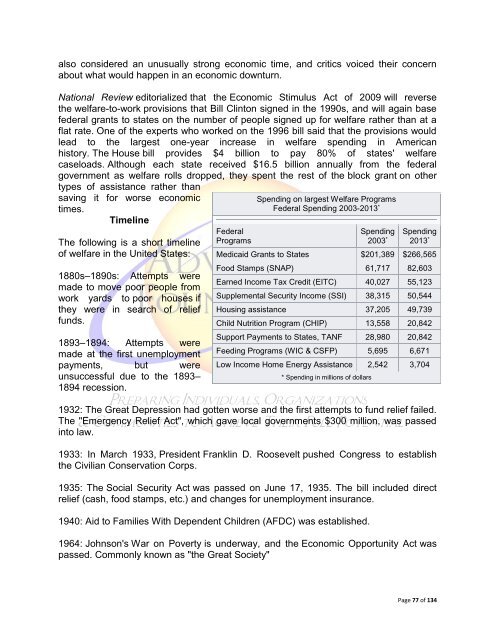Concentrated Poverty
Concentrated Poverty
Concentrated Poverty
Create successful ePaper yourself
Turn your PDF publications into a flip-book with our unique Google optimized e-Paper software.
also considered an unusually strong economic time, and critics voiced their concern<br />
about what would happen in an economic downturn.<br />
National Review editorialized that the Economic Stimulus Act of 2009 will reverse<br />
the welfare-to-work provisions that Bill Clinton signed in the 1990s, and will again base<br />
federal grants to states on the number of people signed up for welfare rather than at a<br />
flat rate. One of the experts who worked on the 1996 bill said that the provisions would<br />
lead to the largest one-year increase in welfare spending in American<br />
history. The House bill provides $4 billion to pay 80% of states' welfare<br />
caseloads. Although each state received $16.5 billion annually from the federal<br />
government as welfare rolls dropped, they spent the rest of the block grant on other<br />
types of assistance rather than<br />
saving it for worse economic<br />
times.<br />
Timeline<br />
The following is a short timeline<br />
of welfare in the United States:<br />
1880s–1890s: Attempts were<br />
made to move poor people from<br />
work yards to poor houses if<br />
they were in search of relief<br />
funds.<br />
1893–1894: Attempts were<br />
made at the first unemployment<br />
payments, but were<br />
unsuccessful due to the 1893–<br />
1894 recession.<br />
Federal<br />
Programs<br />
Spending on largest Welfare Programs<br />
Federal Spending 2003-2013 *<br />
1932: The Great Depression had gotten worse and the first attempts to fund relief failed.<br />
The "Emergency Relief Act", which gave local governments $300 million, was passed<br />
into law.<br />
1933: In March 1933, President Franklin D. Roosevelt pushed Congress to establish<br />
the Civilian Conservation Corps.<br />
1935: The Social Security Act was passed on June 17, 1935. The bill included direct<br />
relief (cash, food stamps, etc.) and changes for unemployment insurance.<br />
1940: Aid to Families With Dependent Children (AFDC) was established.<br />
Spending<br />
2003 *<br />
Spending<br />
2013 *<br />
Medicaid Grants to States $201,389 $266,565<br />
Food Stamps (SNAP) 61,717 82,603<br />
Earned Income Tax Credit (EITC) 40,027 55,123<br />
Supplemental Security Income (SSI) 38,315 50,544<br />
Housing assistance 37,205 49,739<br />
Child Nutrition Program (CHIP) 13,558 20,842<br />
Support Payments to States, TANF 28,980 20,842<br />
Feeding Programs (WIC & CSFP) 5,695 6,671<br />
Low Income Home Energy Assistance 2,542 3,704<br />
* Spending in millions of dollars<br />
1964: Johnson's War on <strong>Poverty</strong> is underway, and the Economic Opportunity Act was<br />
passed. Commonly known as "the Great Society"<br />
Page 77 of 134

















